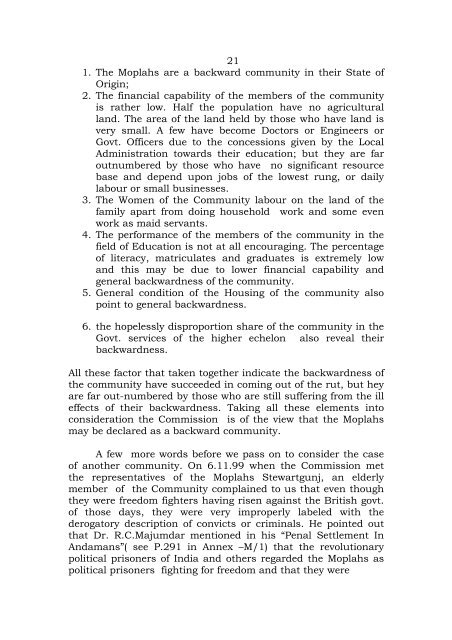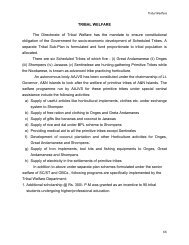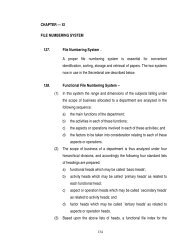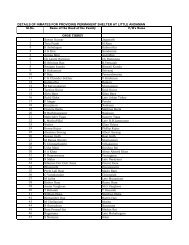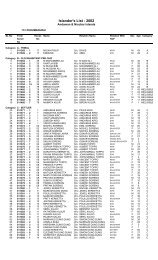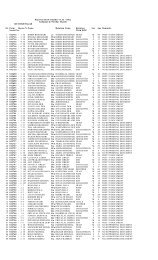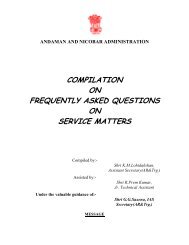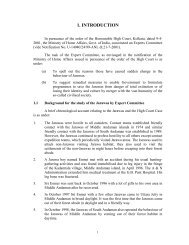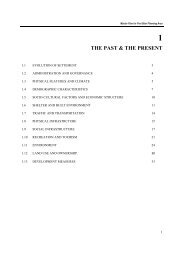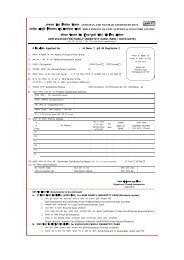Part III - Andaman and Nicobar Islands
Part III - Andaman and Nicobar Islands
Part III - Andaman and Nicobar Islands
You also want an ePaper? Increase the reach of your titles
YUMPU automatically turns print PDFs into web optimized ePapers that Google loves.
21<br />
1. The Moplahs are a backward community in their State of<br />
Origin;<br />
2. The financial capability of the members of the community<br />
is rather low. Half the population have no agricultural<br />
l<strong>and</strong>. The area of the l<strong>and</strong> held by those who have l<strong>and</strong> is<br />
very small. A few have become Doctors or Engineers or<br />
Govt. Officers due to the concessions given by the Local<br />
Administration towards their education; but they are far<br />
outnumbered by those who have no significant resource<br />
base <strong>and</strong> depend upon jobs of the lowest rung, or daily<br />
labour or small businesses.<br />
3. The Women of the Community labour on the l<strong>and</strong> of the<br />
family apart from doing household work <strong>and</strong> some even<br />
work as maid servants.<br />
4. The performance of the members of the community in the<br />
field of Education is not at all encouraging. The percentage<br />
of literacy, matriculates <strong>and</strong> graduates is extremely low<br />
<strong>and</strong> this may be due to lower financial capability <strong>and</strong><br />
general backwardness of the community.<br />
5. General condition of the Housing of the community also<br />
point to general backwardness.<br />
6. the hopelessly disproportion share of the community in the<br />
Govt. services of the higher echelon also reveal their<br />
backwardness.<br />
All these factor that taken together indicate the backwardness of<br />
the community have succeeded in coming out of the rut, but hey<br />
are far out-numbered by those who are still suffering from the ill<br />
effects of their backwardness. Taking all these elements into<br />
consideration the Commission is of the view that the Moplahs<br />
may be declared as a backward community.<br />
A few more words before we pass on to consider the case<br />
of another community. On 6.11.99 when the Commission met<br />
the representatives of the Moplahs Stewartgunj, an elderly<br />
member of the Community complained to us that even though<br />
they were freedom fighters having risen against the British govt.<br />
of those days, they were very improperly labeled with the<br />
derogatory description of convicts or criminals. He pointed out<br />
that Dr. R.C.Majumdar mentioned in his “Penal Settlement In<br />
<strong>Andaman</strong>s”( see P.291 in Annex –M/1) that the revolutionary<br />
political prisoners of India <strong>and</strong> others regarded the Moplahs as<br />
political prisoners fighting for freedom <strong>and</strong> that they were
22<br />
treated by them at a par with the Sepoy Mutineers of 1857,<br />
Wahabis, <strong>and</strong> Thadwady rebels of Burma who were all kept as<br />
prisoners in the <strong>Andaman</strong>s. The Moplahs request the govt. to<br />
take these facts into consideration <strong>and</strong> to take appropriate<br />
action for washing away the stigma from which they have been<br />
suffering <strong>and</strong> to give their ancestors their due by describing<br />
them as freedom fighters. This dem<strong>and</strong> of the Moplahs has<br />
nothing to do with the Commission; yet it is included in the<br />
report as the Moplahs want that they be recognized by the govt.<br />
as descendants of freedom fighters rather than convicts. The<br />
Commission request the Govt. to consider this dem<strong>and</strong> of the<br />
Moplahs with all the seriousness it deserves.<br />
The Karens.<br />
Next we take up the case of the Karens . They are<br />
Mongoloid tribals from Bruma. They migrated from Bassein in<br />
Burma in 1925 on the promise of a grant of l<strong>and</strong> <strong>and</strong><br />
employment in the Forest Department. They formed a separate<br />
free colony in the Middle <strong>Andaman</strong> near Stewart Sound. They<br />
are all Christians of the Baptist sect. At the time of the Census<br />
in 1931, there were 133 males <strong>and</strong> 130 females; see p.35 of the<br />
Census Report of 1931;(Annex-B/1 of Bhantu file).<br />
The Karen families were allowed to settle in pockets near<br />
Mayabunder by clearing the Forest. In due course the karens<br />
worked not only as labourers in the Forest Department but also<br />
started cultivation in the cleared patches. They have been living<br />
in nine villages viz. Webi, Deopur, Latav, Lucknow, Karmatang<br />
IX <strong>and</strong> X, Bourang <strong>and</strong> Chipo- all situated near Mayabunder.<br />
Their present day number may be 2000. though Christians they<br />
retain much of their traditional tribal way of living <strong>and</strong> have the<br />
reputation of being a simple, honest <strong>and</strong> hard working people<br />
who ordinarily keep themselves to themselves.<br />
Social condition of the Karens<br />
From the statement of Smti. Frieda George, Member-<br />
Advisor of the Karen Youth Organisation another before this<br />
Commission <strong>and</strong> a report drawn up by Sri S.A.Awaradi, the<br />
then Director(Tribal Welfare) of the <strong>Andaman</strong> <strong>and</strong> <strong>Nicobar</strong><br />
Administration(Annex-K/1) it appears that the Karens are<br />
mainly agriculturists. They cultivate their own l<strong>and</strong>. Area of<br />
holding per family is about 5 acres <strong>and</strong> they grow-paddy the<br />
yield being about 5 quintals per acre. The women labour on the
23<br />
fields belonging to the family <strong>and</strong> so also do the children on<br />
holidays. Previously they used to go for hunting <strong>and</strong> shell<br />
fishing; but they go no more since these have been banned. Boys<br />
of the community labour under Schemes sponsored by the<br />
Govt;(copy of the statement made be Smti Frieda George is in<br />
Karen file).<br />
State of Education among the Karens.<br />
Previously the Karens did not find any interest in higher<br />
education since they felt quite happy with their free hunting,<br />
fishing <strong>and</strong> cultivating pattern of life. But the restrictions on<br />
hunting <strong>and</strong> shell fishing made them to realise the necessity of<br />
education. Thereafter, gradually there has grown a tendency to<br />
go for higher <strong>and</strong> technical studies.<br />
Smti. Frieda George informs the Commission that even<br />
thought most of the Children go for primary education they<br />
usually stop at that since their parents are too poor to provide<br />
for their uniforms, text-books etc. Up to date only 20/25 boys<br />
<strong>and</strong> girls have passed the Secondary Examination <strong>and</strong> 10/15<br />
Higher Secondary. There are only one BE <strong>and</strong> one Diploma<br />
holder in Civil Engineering <strong>and</strong> only one has passed out from a<br />
Technical Institute as a welder. There is only one doctor.<br />
Economic Condition among Karens<br />
The Karens – as a whole are not a very prosperous<br />
community. By their agricultural pursuits <strong>and</strong> working as<br />
labourers they just manage to pay their way. This is also<br />
because they are accustomed to lead a simple, tribal life without<br />
much want.<br />
Most of the Karen houses are built on stilts traditionally,<br />
with a very large number having floors made of plank, sticks,<br />
mud or mat. The walls are mostly made of mat, planks, or mat<br />
<strong>and</strong> thatch. The houses mostly have thatched roofs <strong>and</strong> tins are<br />
also being used. Without an hesitation these may be called<br />
katcha houses. The doors of the these housed have no door<br />
leaves <strong>and</strong> there is no provisions of locking up the openings.(see<br />
report of Sri Awaradi at page 4 <strong>and</strong> the Appendix attached<br />
thereto- at page 12, Annex- B/1 of Bhantu file).
24<br />
Smti Frieda George informs that Commission that the only<br />
doctor of the Community is in Class A service <strong>and</strong> that she<br />
herself along as the Principal of the Nursing Training School of<br />
the Isl<strong>and</strong>s is in Group B. there are 58/59 in Group-C in<br />
Medical, Police, Transport, Education, Veterinary etc. <strong>and</strong> about<br />
10/15 in Group D as watchmen, ward-attendants etc.<br />
From the informations detailed above, it becomes quite<br />
clear that the Karens fully deserve being designated as OBCs.<br />
1. They are a tribal people <strong>and</strong> it is common knowledge that<br />
tribals are backward everywhere. The Karens are no<br />
exception. Their almost total dependence on agriculture<br />
<strong>and</strong> working as labourers, <strong>and</strong> the part played by their<br />
women <strong>and</strong> children show their backwardness. Nobody<br />
says that they ever had a member in any Gram Panchayat.<br />
2. Their poor participation in the educational activities<br />
whether in the lower or the higher rungs also indicates<br />
their backwardness.<br />
3. The kutcha houses of the Karens indicate their<br />
backwardness. So also do their representation in Group A<br />
<strong>and</strong> B Posts by only one member of the community each.<br />
The greater representation of the community in C <strong>and</strong> D<br />
Groups of Posts also show just that.<br />
Had the Karens been an Indian Tribe they would have in<br />
all certainty been given the status of a Scheduled Tribe in<br />
recognition of the general backwardness of tribals. Here in these<br />
Isl<strong>and</strong>s all we can do in view so their being Tribals together<br />
with their backwardness in social, Educational <strong>and</strong> Economic<br />
fields is to recommend for their inclusion in the list of OBCs of<br />
the Isl<strong>and</strong>s.<br />
Local Borns<br />
Now we take up the case of the Local Borns. We have<br />
already stated how this community has come into being(see P.6)<br />
we now proceed to consider their condition-social, educational<br />
<strong>and</strong> economic.
25<br />
Social condition of the Local Born.<br />
As a community the Local Borns are considerably more<br />
numerous than the other pre-42 communities. Proportionately<br />
there are more educated <strong>and</strong> more qualified men amongst<br />
themselves. But for historical reasons over which the Local born<br />
had no control <strong>and</strong> the ensuing non-adherence to the orthodox<br />
customs of caste, especially in matrimonial alliances, the<br />
Mainl<strong>and</strong>er did not <strong>and</strong> still does not consider the Local Born<br />
quite the same as himself. This discrimination acts as a negative<br />
force in keeping him tied to this moorings <strong>and</strong> st<strong>and</strong>s in his way<br />
of spiraling up <strong>and</strong> competing with the Mainl<strong>and</strong>er.<br />
2. As per the Classification Table(See Page I) drawn up on the<br />
basis of the sample survey, the income of the Local Born source<br />
wise is as follows:-<br />
Col.6. Agriculture = 7.94<br />
Col.7. Wage = 8.88<br />
Col.8. Others = 81.34<br />
Mr. Govind Ram, General Secretary of the Local Born<br />
Association who met the Commission along with Mr.John Lobo,<br />
President <strong>and</strong> Dr.Rasheed, Member, Executive Council of the<br />
said Association asserted that the figure against Col.6 ie.<br />
Agriculture should be more than 7.94 as shown in the Table.<br />
His view finds support from the Office bearers <strong>and</strong> Members of<br />
the Tushnabad Gram Panchayat, Sarpanch, Hobdypur <strong>and</strong> Smti.<br />
Sumitra Devi, Member, Zilla Parishad whom the Commission<br />
met on 29.04.2000. The Commission was told that there are 80<br />
pre-1942 families at Tushnabad Village <strong>and</strong> 50 pre-1942 families<br />
at Hobdipur village. It is asserted that agriculture is the main<br />
occupation of the villagers whose predecessors were settled in<br />
these two villages in or about 1900. At the time of the settlement<br />
each family was allotted 3 to 4 acres of paddy l<strong>and</strong>, a house site<br />
<strong>and</strong> 7/8 bighas of l<strong>and</strong> for horticultural purposes. After so<br />
many years each married family has 1/2 bighas of l<strong>and</strong> <strong>and</strong><br />
many have no l<strong>and</strong> at all . Yield of paddy is about 25 mds. per<br />
acre. From agriculture a family earns about Rs.8000/- a year.<br />
The supplement their income the male members works as daily<br />
rated labourers for about three months in a year during off<br />
agricultural season <strong>and</strong> also go for fishing . The situation is
26<br />
quite the same in Hobdypur village also; ( Copies of statements<br />
recorded in Local Born files).<br />
This Commission finds these assertions fully acceptable.<br />
The Situation in the town areas may be different. But in the<br />
rural areas, so we see, the people are still mostly agriculturists.<br />
Since the income from agriculture is not adequate, the people try<br />
to supplement their income by wages earned by working as daily<br />
rated labourers or by doing some other strenuous job, such as<br />
catching <strong>and</strong> selling fishes. The figure shown under Col.8 i.e<br />
81.34 must be representing those off time labourers. The results<br />
of the sample survey should be read <strong>and</strong> understood in that<br />
context.<br />
The wage earners shown as 8.88% represent Govt.<br />
Servants –who as we will see later-mostly comprise C <strong>and</strong> D<br />
group employees. This figure is not disputed.<br />
It follows, therefore, that most of the Local Born people of<br />
the villages are agriculturists cum daily rated labourers- both<br />
labour intensive pursuits. This surely goes to show the<br />
backwardness of the people, which is further endorsed by the<br />
fact that of the meager section of the people serving the State<br />
mostly belong to Group C <strong>and</strong> D. What is true with regard to<br />
Tusnabad Hobdypur or Pokadera must be true with regard to the<br />
other Local born people living in the rural area.<br />
Another factor is womens’ contribution to the family<br />
efforts. The proportion in this regard has been shown under<br />
Col.9 as 1.84. Shri Govind Ram, the General Secretary of the<br />
Local Born Association, Port Blair, does not dispute this figure<br />
as- so he says- “our women usually do not go out for working in<br />
the fields”. This however, is not the impression which the<br />
Commission got at Tushnabad or from the members of Pokadera<br />
Gram Panchayat. There the Commission was told that the<br />
women <strong>and</strong> the children of the Local Born Community also<br />
participated in agricultural operations, such as transplanting,<br />
harvesting of paddy, collection of fodder for the cattle etc. The<br />
Commission finds the latter view fully acceptable since the<br />
Commission feels that it is not very likely that the women would<br />
sit idly at home where the males of the families would gout for<br />
working as days- labourers. It may be that as in the mainl<strong>and</strong>,<br />
the city bred ladies of the educated middle class families<br />
“Usually do not go out for working in the fields”, but the
27<br />
Commission refuses to believe that this is the rule also with the<br />
ladies of the rural areas.<br />
Educational St<strong>and</strong>ard among the Local Born<br />
As per the Classification Table(see page 2) the state of<br />
education amongst the Local Born is as follows:-<br />
Col.6, Literacy Rate = 84.33%<br />
Col.7, Matriculates = 30.66%<br />
Col.8, Graduates = 6.53%<br />
The literacy rate seems to be much less than the State<br />
average of 97%. Even then Shri Govind Ram says that in the<br />
older generation the percentage of literacy will not be more than<br />
20%. This surely is a mark of backwardness, since education is<br />
free in the Isl<strong>and</strong>s.<br />
The percentages of Matriculates <strong>and</strong> Graduates are near<br />
the State average which are 30.7 <strong>and</strong> 4.8. These figures also<br />
appear to be low. Shri Govind Ram says that the percentage of<br />
matriculates amongst the Local Born may be around 22%. In<br />
Tushnabad <strong>and</strong> Hobdypur the percentage is said to be 10%<br />
which is very likely since there are rural areas.<br />
We are also informed at Tushnabad that there are 1/2%<br />
dropouts at primary level, 5% at eighth level <strong>and</strong> 20% in School<br />
final level. The dropouts cannot prosecuted their studies any<br />
further due to the poverty of their parents.<br />
The state of education amongst the Local Born, though<br />
perhaps a bit better than the other communities, does not<br />
appear to be very encouraging.<br />
Economic St<strong>and</strong>ard of the Local Born.<br />
In Col.6 of the 3 rd page of the Classification Table the<br />
percentage of families living in Katcha houses has been shown<br />
as 17.80%. This is disputed by Shri Govind Ram who asys that<br />
the percentage should be at least 35% to 40% especially in the<br />
rural areas. At Tushnabad the Commission was told that 60% of<br />
the houses were Katcha or semi pucca. The remaining 40% were<br />
pucca, but with sheet roofing. We may take it, therefore, that of
28<br />
the houses of the Local Borns at least 40% are Kutcha <strong>and</strong> 20%<br />
are semi pucca ie. Having brick- built floors but without having<br />
pucca walls <strong>and</strong> roof <strong>and</strong> that in the remaining 40% the floors<br />
<strong>and</strong> the walls are brick built, but the roofs are made with sheet<br />
roofing. It will be quite proper to conclude that even though in<br />
the city area there may be some pucca houses, in the rural areas<br />
the houses are mostly kutcha or semi pucca i.e having brick<br />
built floors but walls <strong>and</strong> roofs made with flimsy material.<br />
Now we turn to see how may are the job holders amongst<br />
the Local Born <strong>and</strong> of which Category.<br />
From columns 8 <strong>and</strong> 10 of the page 3 of the Classification<br />
Table it appears that there are 54 Group A post-holders <strong>and</strong> 82<br />
Group B post holders in the community. This is considerably<br />
more than the other three communities. But yet the percentages<br />
come nowhere near the population. – equivalent proportion of<br />
the Community, since there are 344 Group A post <strong>and</strong> 458<br />
Group B posts in the local Administration. Even then Shri<br />
Govind Ram says that the number of Group A post holders will<br />
not be more than 45/46 <strong>and</strong> that of group B post holders not<br />
more than 70/75. We were told at Tushnabad that of the 30<br />
graduates in the area, about 15 are unemployed. There are only<br />
two clerks <strong>and</strong> two teachers <strong>and</strong> of the two Diploma Holders of<br />
the Community only one could get a job. In Hobdypur there are<br />
4 teachers, one clerk <strong>and</strong> one nurse. There is no doctor or<br />
Engineer in either village.<br />
Conclusion<br />
1. The discrimination suffered by the Local Born is akin to<br />
caste-discrimination <strong>and</strong> acting as a damper to his spirit, it<br />
induces him to keep himself within his shell <strong>and</strong> not to<br />
prepare himself for competing with the mainl<strong>and</strong>er who is<br />
already in a better position socially, educationally <strong>and</strong><br />
financially.<br />
2. Excepting the well educated city-based the Local Born in<br />
the rural areas are employed in agriculture <strong>and</strong> such other<br />
labour intensive jobs. Quite a large number has to work as<br />
day- labourers for survival <strong>and</strong> the women <strong>and</strong> children of<br />
the community also join h<strong>and</strong>s with the adult males in<br />
their agricultural pursuits. Though mainly agriculturist
29<br />
many of the community have practically become l<strong>and</strong>less<br />
since after the settlement about a hundred years ago there<br />
was no further settlement of l<strong>and</strong> with the members of the<br />
community. Thus many of the community actually lack a<br />
significant resource base. Dependence on labour intensive<br />
activities <strong>and</strong> lack of significant resource base for many<br />
indicate backwardness of the community.<br />
3. The educational st<strong>and</strong>ard among the Local Born is not also<br />
very encouraging. The literacy rate is much below the state<br />
Average. The percentages of Matriculates is below the<br />
State Average, Whereas the percentage of Graduates is a<br />
bit above. All this shows backwards of the community even<br />
though a section amongst them succeeded in educating<br />
themselves in a proper way by their own efforts in spite of<br />
adverse circumstances.<br />
4. The Economic St<strong>and</strong>ard of the local Born is not also as<br />
could be desired. In <strong>and</strong> around Port Blair there are some<br />
amongst them who succeeded in getting Govt. Jobs <strong>and</strong> are<br />
in a position to maintain a reasonable st<strong>and</strong>ard. But that<br />
is not the case with those living in the rural areas. There<br />
quite a large number among them- the percentage maybe<br />
40% or even above still live in Kutcha Houses. Many others<br />
live in mixed kutcha- pucca hosues <strong>and</strong> very few have fully<br />
pucca houses. The state of housing certainly indicates<br />
backwardness.<br />
5. It also appears that even though there are a number of<br />
Group A <strong>and</strong> Group B post holders in the community their<br />
percentages come nowhere near the population- equivalent<br />
proportion of the community. This is also an indication of<br />
backwardness.<br />
6. The hopelessly disproportion share of the community in<br />
the Govt. services of the higher echelon also reveal their<br />
backwardness.
30<br />
We see, therefore, that even though the Community is a bit<br />
forward in comparison with the other communities, its members<br />
suffer from many deficiencies is social, educational <strong>and</strong><br />
economic fields which reveal its backwardness. It will be proper,<br />
therefore, to recommend its inclusion in the list of OBCs of the<br />
Isl<strong>and</strong>s.<br />
Bengali Settlers<br />
Lastly we take up the case of the Bengali Settlers. We have<br />
already stated elsewhere who are they, when they were brought<br />
<strong>and</strong> settled here <strong>and</strong> by home. We now turn to consider the<br />
materials collected to decided if the community deserves to be<br />
designated as one OBCs of the isl<strong>and</strong>s.<br />
Social condition of the Bengali Settlers.<br />
Since after 1931, there has not been any census in these<br />
isl<strong>and</strong>s on caste basis. As such there are no official records to<br />
indicate to what particular caste or castes do the Bengali Settlers<br />
belong. It is common knowledge, however, that the overwhelming<br />
majority of them belong to the caste of “Namasudras” a caste<br />
included in the list of the Scheduled Caste in West Bengal. See<br />
Annex –BS/1, Sl.No.46 in Bengali Settlers’ File. According to the<br />
statement submitted by the President of BAANI(Bengal<br />
Association, <strong>Andaman</strong> <strong>Nicobar</strong> Isl<strong>and</strong>s), an organization of the<br />
Bengali Settlers, the present day number of Bengali Settlers is<br />
1,09,500 <strong>and</strong> their caste-wise proportions are as follows:-<br />
1. Namasudras - 95%<br />
(Scheduled Caste)<br />
2. Sudras - 2%<br />
(Scheduled Caste)<br />
3. Barai, Baishya, - 1%<br />
Kayasthas etc<br />
4.Brahmins - 1%


